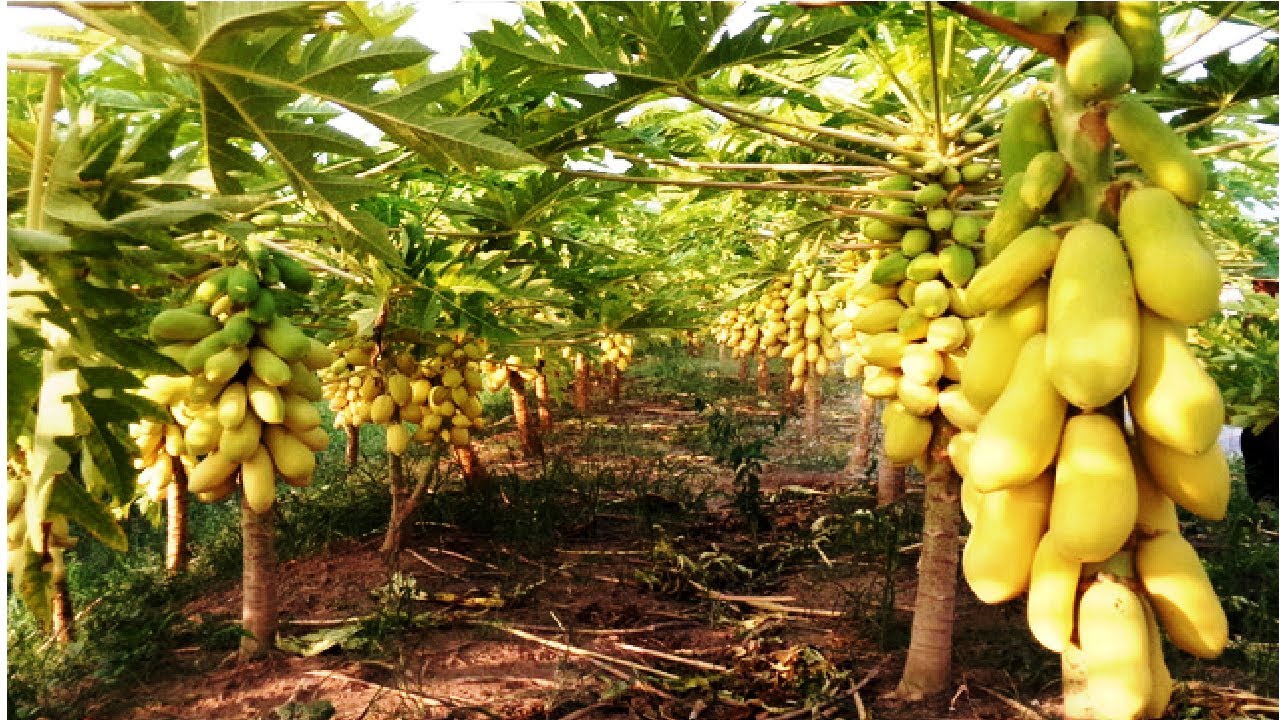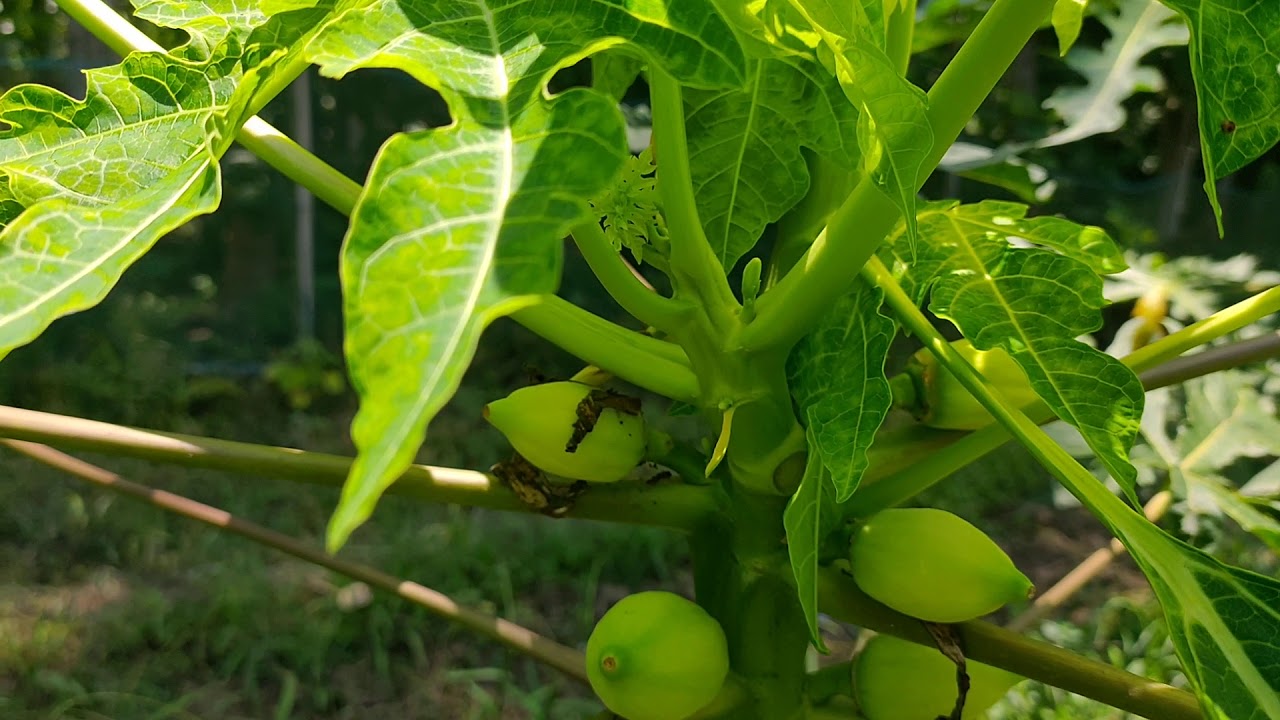Wheat is a staple crop that requires specific soil management and fertilization practices to achieve ...
Papaya is a highly nutritious fruit loaded with medicinal properties. Its consumption helps regulate cholesterol and excess body fat, and it proves beneficial in treating various ailments. Papaya can be easily cultivated alongside other crops. This farming is not only simple but also requires minimal effort and investment. Offering high profits with low space and cost, papaya cultivation has become an excellent option for farmers.
पपीता एक बेहद पौष्टिक और औषधीय गुणों से भरपूर फल है। इसके सेवन से शरीर में कोलेस्ट्रॉल और अतिरिक्त चर्बी नियंत्रित रहती है, साथ ही यह कई बीमारियों में लाभकारी साबित होता है। पपीता को अन्य फसलों के साथ मिलाकर भी आसानी से उगाया जा सकता है। इसकी खेती न केवल सरल है, बल्कि इसमें ज्यादा मेहनत और लागत की भी जरूरत नहीं होती। कम जगह और कम खर्च में अधिक मुनाफा देने वाली यह खेती, किसानों के लिए एक बेहतरीन विकल्प बन चुकी है।
पपीता की सफल खेती के लिए मिट्टी का चुनाव बेहद जरूरी है। किसी भी पौधे को लगाने से पहले यह जानना आवश्यक होता है कि कौन-सी मिट्टी उसके लिए अधिक लाभदायक होगी, ताकि किसान अधिक मुनाफा कमा सके। पपीता की खेती के लिए भूमि उपजाऊ और अच्छी जल निकासी वाली होनी चाहिए। बहुत कठोर या भारी काली मिट्टी पपीते के लिए उपयुक्त नहीं मानी जाती। इसके अलावा, जिस स्थान पर पौधा लगाया जा रहा हो वहां पानी रुकना नहीं चाहिए, क्योंकि जलभराव से पौधों में कॉलर रॉट जैसी बीमारी होने का खतरा बढ़ जाता है।
पौधे लगाने से पहले खेत की अच्छी तरह जुताई करना बेहद जरूरी है, ताकि खेत पूरी तरह समतल हो जाए और वर्षा के दौरान पानी जमा न हो। पानी के ठहराव से फसलों को नुकसान पहुंच सकता है। पपीते के पौधे लगाने के लिए लगभग 2 मीटर लंबा और चौड़ा गड्ढा तैयार करें, ताकि पौधों को पर्याप्त जगह और पोषण मिल सके।

भारत के अधिकांश हिस्सों में पपीते की खेती आसानी से की जा सकती है। हालांकि इसे पूरे साल किसी भी समय लगाया जा सकता है, लेकिन बेहतर उत्पादन के लिए सही समय का चयन जरूरी होता है। जहां सिंचाई की समुचित व्यवस्था न हो, वहां जून से जुलाई के बीच पपीते के पौधे लगाना अधिक लाभकारी होता है, क्योंकि इस अवधि में नियमित वर्षा के कारण सिंचाई की आवश्यकता कम होती है। वहीं, जिन क्षेत्रों में सिंचाई की सुविधा उपलब्ध है, वहां सितंबर–अक्टूबर या फिर फरवरी–मार्च में पौधे लगाना उपयुक्त रहता है। पपीते की खेती के लिए सामान्य तापमान वाले वातावरण की आवश्यकता होती है।
खेत की जुताई के बाद, तैयार किए गए 2 मीटर आकार के गड्ढों में पौधे लगाने से पहले उनमें उचित मात्रा में उर्वरक मिलाकर भरना आवश्यक होता है। प्रत्येक गड्ढे में लगभग 20 किलो सड़ी हुई गोबर की खाद, 500 ग्राम सुपर फास्फेट और 250 ग्राम म्यूरेट ऑफ पोटाश अच्छी तरह मिलाकर भरें और पौधारोपण से लगभग 10 दिन पहले इसे तैयार होने के लिए छोड़ दें। इसके बाद प्रत्येक गड्ढे में 2 बीज लगाए जाएं। एक हेक्टेयर क्षेत्र में पपीता की खेती के लिए लगभग 600 ग्राम से 900 ग्राम बीज की आवश्यकता होती है।
यह भी पढ़ें: आम की खेती
पपीते के पौधे को बोने के लिए सामान्यत: पहले उसे एक पोलिथीन बैग में तैयार किया जाता है, और फिर तैयार किए गए गड्डों में पौधे लगाए जाते हैं। यह तरीका पौधा तैयार करने के लिए प्रभावी है। इसके मुकाबले, यदि बीज सीधे खेत में लगाए जाएं तो उनकी देखभाल अधिक करनी पड़ती है। इसलिए, पौधे को पहले घर या नर्सरी में तैयार करना बेहतर होता है। नर्सरी में पौधों को लगभग 10 सेंटीमीटर की दूरी पर रखा जाना चाहिए, और जब पौधा 20 सेंटीमीटर से बड़ा हो जाए, तब उसे गड्डों में लगा दिया जाता है।
पौधे को लगाने के समय उसे भूमि की सतह से थोड़ा ऊपर रखना चाहिए। इसके साथ ही, पौधे को रोजाना पानी नहीं देना चाहिए, बल्कि सप्ताह में 2 बार पानी देना उचित रहता है। हालांकि, जिन स्थानों पर पानी की अधिक आवश्यकता होती है, वहां पानी की जरूरत के अनुसार देना चाहिए। सर्दियों में, पौधों को 10 दिन के अंतराल पर पानी देना लाभकारी होता है, लेकिन पानी हमेशा सही मात्रा में ही देना चाहिए।

पपीता का फल लगभग 10 महीने में तैयार हो जाता है, और इसका पता आसानी से चलता है। शुरू में पपीता का फल हरे रंग का होता है, लेकिन जब वह पीला पड़ने लगता है, तो इसका मतलब है कि फल पकने के करीब है। इसके अलावा, यदि बिना पके फल को नाखून से खरोंचा जाए, तो उसमें जो दूध निकलता है, वह पकने के बाद बंद हो जाता है और उसकी जगह पानी जैसा तरल पदार्थ निकलने लगता है।
पपीता की सफल खेती के लिए सही समय पर पौधा लगाना, उचित उर्वरक का प्रयोग, सही सिंचाई व्यवस्था, और फलों की सही समय पर कटाई बहुत महत्वपूर्ण हैं। यदि किसान इन पहलुओं का ध्यान रखते हैं, तो उन्हें पपीते की खेती से अच्छा लाभ प्राप्त होगा। इस खेती में कम लागत, कम जगह और कम मेहनत की आवश्यकता होती है, जो इसे किसानों के लिए एक लाभकारी विकल्प बनाती है। इसलिए, पपीते की खेती को एक बेहतर आय स्रोत के रूप में अपनाया जा सकता है।
Choosing the right soil is crucial for the successful cultivation of papaya. Before planting any crop, it is important to know which type of soil is most beneficial, so that farmers can earn better profits. For papaya farming, the soil should be fertile and well-drained. Very hard or heavy black soil is not considered suitable for papaya. Additionally, the planting site must have proper drainage, as waterlogging can lead to diseases like collar rot in the plants.
Before planting, it is essential to plow the field thoroughly so that it becomes completely level and water does not accumulate during the rainy season. Waterlogging can damage the crops. For planting papaya, prepare a pit approximately 2 meters long and wide to ensure the plants receive adequate space and nutrients.
Papaya farming can be easily done in most parts of India. Although it can be planted at any time of the year, choosing the right season ensures better yield. In areas where proper irrigation facilities are not available, planting between June and July is more beneficial due to regular rainfall, which reduces the need for irrigation. In regions with adequate irrigation, planting during September–October or February–March is ideal. Papaya cultivation requires a moderate temperature environment.
After plowing the field, it is necessary to fill the prepared 2-meter-sized pits with an appropriate amount of fertilizer before planting the saplings. In each pit, mix approximately **20 kg of well-rotted cow dung**, **500 grams of super phosphate**, and **250 grams of muriate of potash** thoroughly, and leave it to prepare about **10 days before planting**. After that, plant **2 seeds** in each pit. For one hectare of papaya farming, approximately **600 grams to 900 grams of seeds** are required.
For planting papaya, the plant is generally first prepared in a polythene bag and then transplanted into the prepared pits. This method is effective for preparing the plant. In contrast, if seeds are directly sown in the field, they require more care. Therefore, it is better to first prepare the plant at home or in a nursery. In the nursery, the plants should be spaced about 10 centimeters apart, and when the plant reaches 20 centimeters in height, it can be transplanted into the pits.
When planting, the plant should be placed slightly above the ground level. Additionally, the plant should not be watered daily, but it is recommended to water it twice a week. However, in areas where more water is required, water should be provided according to the need. In winters, watering the plants every 10 days is beneficial, but water should always be given in the right amount.
Papaya fruit is ready for harvest in approximately 10 months, and it is easy to identify when it is ready. Initially, the fruit is green, but when it starts turning yellow, it indicates that the fruit is nearing ripeness. Additionally, if an unripe fruit is scratched with a nail, the milk that comes out stops after the fruit ripens, and a watery liquid replaces it.
For successful papaya farming, it is crucial to plant the sapling at the right time, use appropriate fertilizers, maintain proper irrigation systems, and harvest the fruits at the right time. If farmers focus on these aspects, they can achieve good profits from papaya farming. This type of farming requires low cost, minimal space, and less effort, making it a profitable option for farmers. Therefore, papaya farming can be adopted as a better source of income.
0
0
Wheat is a staple crop that requires specific soil management and fertilization practices to achieve ...
भारत में कृषि न केवल एक प्रमुख आर्थिक � ...
Neem cake is an organic byproduct derived from cold-pressed neem seeds after the extraction of neem ...
खरीफ फसलें-मानसून के मौसम में उगाई जात ...
Rice farming requires careful management of soil nutrients to ensure optimal growth and yield. The a ...
Fertilizers are essential substances used in agriculture to enhance the growth and productivity of c ...
Mango farming is a significant agricultural practice in many tropical and subtropical regions. Known ...
Organic farming is an agricultural practice that focuses on growing crops and raising livestock in a ...
Crop rotation, a key agricultural practice, involves growing different crops in the same field acros ...
Soil fertility is crucial for any farmer or gardening enthusiast. Fertile soil promotes healthy plan ...
Soil testing is a process that provides farmers with crucial information about the quality, nutrient ...
The tradition of farming in India is centuries old, and wheat and barley hold significant importance ...
The Aak plant (Calotropis gigantea) is a remarkable creation of nature, valued for its distinctive f ...
Roses, known for their beauty and enchanting fragrance, are the pride of every garden. However, main ...
Agricultural Pollution refers to the harmful effects caused by agricultural activities on the enviro ...
Temperature fluctuations have a direct impact on wheat farming. It affects sowing, growth, grain for ...
During summer, rising temperatures increase the risk of fire in wheat crops. As April begins, wheat ...
Agroforestry is a term derived from two words: "Agriculture" and "Forestry." It is a land-use system ...
कृषि में आर्टिफिशियल इंटेलिजेंस (AI) क ...
Contour Farming is a very common farming technique practiced in India. It is commonly practiced in h ...
Vegetables to Sow in May : Dear farmer friends, in the month of May, our plants don't usually suff ...
India is an agrarian country with three major agricultural seasons and a variety of crops being prod ...
Leaf curl disease, which causes leaves to curl, is a serious threat to agriculture. This disease aff ...
Intercropping is a farming method where two or more crops are grown together in the same field. It h ...
Mulching is a layer spread over the surface of the soil, primarily aimed at retaining soil moistur ...
India is an agriculture-based country, yet many farmers can’t use their land as it remains barren ...